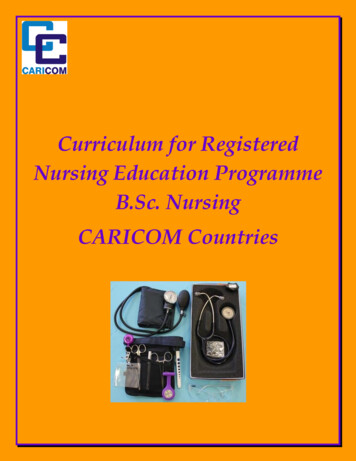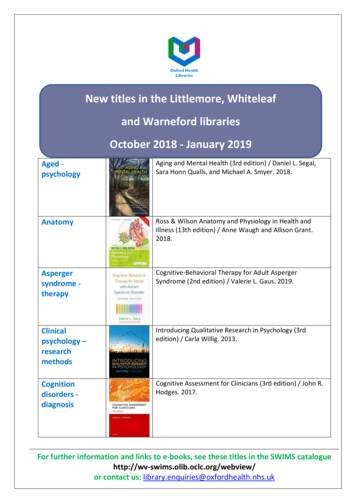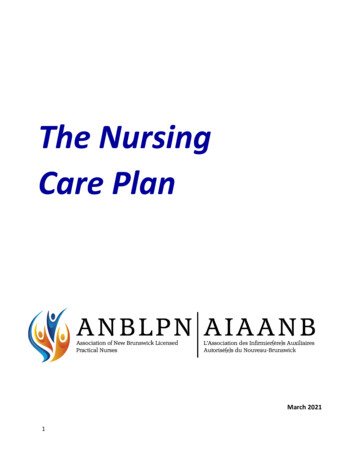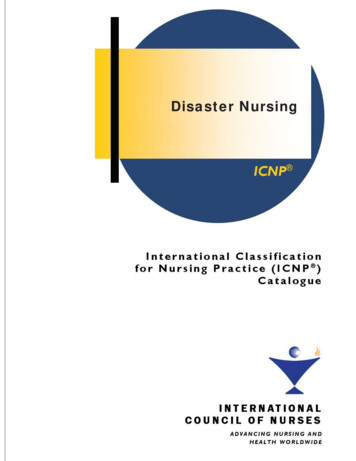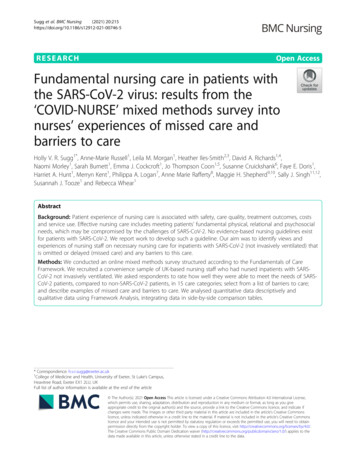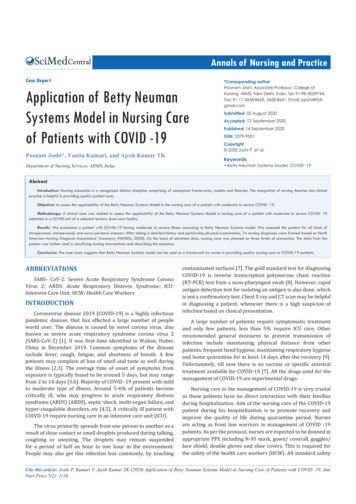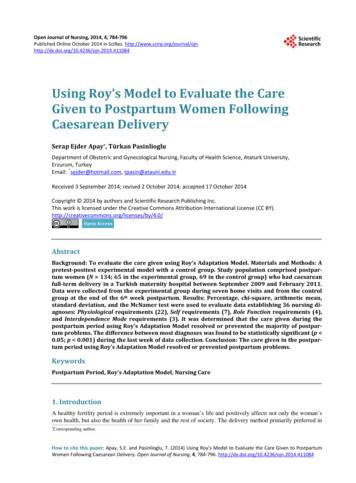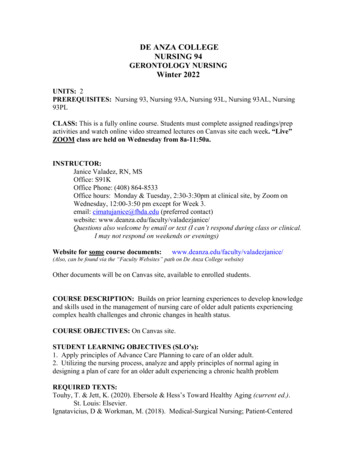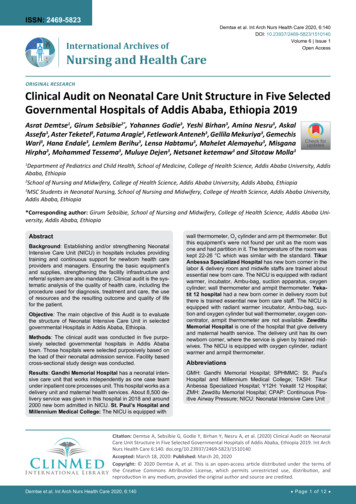
Transcription
ISSN: 2469-5823International Archives ofNursing and Health CareDemtse et al. Int Arch Nurs Health Care 2020, 6:140DOI: 10.23937/2469-5823/1510140Volume 6 Issue 1Open AccessOriginal ResearchClinical Audit on Neonatal Care Unit Structure in Five SelectedGovernmental Hospitals of Addis Ababa, Ethiopia 2019Asrat Demtse1, Girum Sebsibie2*, Yohannes Godie3, Yeshi Birhan3, Amina Nesru3, AskalAssefa3, Aster Teketel3, Fatuma Aragie3, Fetlework Anteneh3, Gellila Mekuriya3, GemechisWari3, Hana Endale3, Lemlem Berihu3, Lensa Habtamu3, Mahelet Alemayehu3, MisganaHirpha3, Mohammed Tessema3, Muluye Dejen3, Netsanet ketemaw3 and Sitotaw Molla3Check forupdatesDepartment of Pediatrics and Child Health, School of Medicine, College of Health Science, Addis Ababa University, AddisAbaba, Ethiopia2School of Nursing and Midwifery, College of Health Science, Addis Ababa University, Addis Ababa, Ethiopia3MSC Students in Neonatal Nursing, School of Nursing and Midwifery, College of Health Science, Addis Ababa University,Addis Ababa, Ethiopia1*Corresponding author: Girum Sebsibie, School of Nursing and Midwifery, College of Health Science, Addis Ababa University, Addis Ababa, EthiopiaAbstractBackground: Establishing and/or strengthening NeonatalIntensive Care Unit (NICU) in hospitals includes providingtraining and continuous support for newborn health careproviders and managers. Ensuring the basic equipment’sand supplies, strengthening the facility infrastructure andreferral system are also mandatory. Clinical audit is the systematic analysis of the quality of health care, including theprocedure used for diagnosis, treatment and care, the useof resources and the resulting outcome and quality of lifefor the patient.Objective: The main objective of this Audit is to evaluatethe structure of Neonatal Intensive Care Unit in selectedgovernmental Hospitals in Addis Ababa, Ethiopia.Methods: The clinical audit was conducted in five purposively selected governmental hospitals in Addis Ababatown. Those hospitals were selected purposively based onthe load of their neonatal admission service. Facility basedcross-sectional study design was conducted.Results: Gandhi Memorial Hospital has a neonatal intensive care unit that works independently as one case teamunder inpatient core processes unit. This hospital works as adelivery unit and maternal health services. About 8,500 delivery service was given in this hospital in 2018 and around2000 new born admitted in NICU. St. Paul’s Hospital andMillennium Medical College: The NICU is equipped withwall thermometer, O2 cylinder and arm pit thermometer. Butthis equipment’s were not found per unit as the room wasone and had partition in it. The temperature of the room waskept 22-26 C which was similar with the standard. TikurAnbessa Specialized Hospital has new born corner in thelabor & delivery room and midwife staffs are trained aboutessential new born care. The NICU is equipped with radiantwarmer, incubator, Ambu-bag, suction apparatus, oxygencylinder; wall thermometer and armpit thermometer. Yekatit 12 hospital had a new born corner in delivery room butthere is trained essential new born care staff. The NICU isequipped with radiant warmer incubator, Ambu-bag, suction and oxygen cylinder but wall thermometer, oxygen concentrator, armpit thermometer are not available. ZewdituMemorial Hospital is one of the hospital that give deliveryand maternal health service. The delivery unit has its ownnewborn corner, where the service is given by trained midwives. The NICU is equipped with oxygen cylinder, radiantwarmer and armpit thermometer.AbbreviationsGMH: Gandhi Memorial Hospital; SPHMMC: St. Paul’sHospital and Millennium Medical College; TASH: TikurAnbessa Specialized Hospital; Y12H: Yekatit 12 Hospital;ZMH: Zewditu Memorial Hospital; CPAP: Continuous Positive Airway Pressure; NICU: Neonatal Intensive Care UnitCitation: Demtse A, Sebsibie G, Godie Y, Birhan Y, Nesru A, et al. (2020) Clinical Audit on NeonatalCare Unit Structure in Five Selected Governmental Hospitals of Addis Ababa, Ethiopia 2019. Int ArchNurs Health Care 6:140. doi.org/10.23937/2469-5823/1510140Accepted: March 18, 2020: Published: March 20, 2020Copyright: 2020 Demtse A, et al. This is an open-access article distributed under the terms ofthe Creative Commons Attribution License, which permits unrestricted use, distribution, andreproduction in any medium, provided the original author and source are credited.Demtse et al. Int Arch Nurs Health Care 2020, 6:140 Page 1 of 12
DOI: 10.23937/2469-5823/1510140IntroductionA neonatal intensive care unit (NICU), also known asan intensive care nursery (ICN), is an intensive care unitspecializing in the care of ill or premature newborn infants. Neonate refers to the first 28 days of life. Neonatal care, also known as specialized nurseries or intensivecare has been started since the 1960s [1].Newborn intensive care is given for critically ill newborns requiring constant nursing, complicated surgicalprocedures, regular respiratory support, or other intensive interventions. The first American newborn intensivecare unit, designed by Louis Gluck, was opened in October 1960 at Yale New Haven Hospital. NICU is typicallydirected by one or more neonatologists and staffed bynurses, nurse practitioners, pharmacists, physician assistants, resident physicians, respiratory therapists, anddietitians. Many other ancillary disciplines and specialists are available at larger units [1].Every day, a significant number of neonates are admitted to neonatal intensive care units (NICU). Someof the main reasons behind NICU referrals are pretermbirth and low birth weight. Every year, 15 million infantsare born prematurely worldwide [2]. Previous studiesdetermined that the quality of developmental care provided to preterm infants is affected by certain contributing factors, such as nurses’ age, years of work experience, educational level and nurse-patient ratio [3].Clinical audit is the systematic analysis of the quality of health care, including the procedure used fordiagnosis, treatment and care, the use of resourcesand the resulting outcome and quality of life for thepatient. Clinical audit is one of the key elements ofclinical governance, the latter being a system throughwhich healthcare organizations are accountable forcontinuously improving the quality of services. It isdescribed as ‘‘a framework through which organizations are accountable to continue to improve thequality of the service and safeguard high standards ofcare by creating environment in which excellence inclinical care would flourish’’ [4].In Ethiopia, neonatal health care services have beenremaining less consolidated, systematic efforts havebeen gaining momentum recently. Standard of neonatal health care at all events is now in process and preparedness and readiness of the formal health care system have been in progress. According to the estimatesof the American Academy of Pediatrics, nearly 5% of allthe newborns may requires Level III (or Intensive careunit) whilst another 15-20% of all the newborns may require Level II (Specialty) services [5].The NICU shall have a clearly identified entranceand reception area for families. On entrance thereshall be good acceptance that may make familiesto feel as part of their babies’ health care giver. Itshould be designed as good security program thatDemtse et al. Int Arch Nurs Health Care 2020, 6:140ISSN: 2469-5823protect physical safety of infants, families and staff inthe NICU [6]. Hand washing is an important issue inprevention of infection; so there shall be hand washing station in NICU at a distance of not more than 6mfrom each bed of the neonate. Water supply shouldbe available 24 hrs/7 day per week as it is the mostimportant for infection prevention and control inhealth facilities. Hospital-born babies in developingcountries are at increased risk of infections due topoor infection-control practices. Effective infectionprevention and control reduces hospital-acquired infections by 30% [7].Among physical structure of NICU sound generatingactivities are the most important that need attention forneonatal wellbeing and safety. But it is difficult to control noise and noise generating activities as NICU noisemostly generated from care activities and professionalconduct, such as alarm sounds from different machines.Studies show that incubators can deliver sound thatcause deafness of newborn which can be generated byrepeated bounces of sound against the hard wall of thedome, amplifying the noise that reaches the neonate[8,9].An efficient and nurturing physical environmentis critical for the support of premature infants, theirfamilies, and the healthcare staff that care for them.This clinical audit is to assess the neonatal intensivecare unit structure in five purposively selected government hospitals in Addis Ababa. This audit identified potentials problems and challenges encounteredon NICU structural service. The audit finding will beimportant for Baseline information, Policy maker regarding NICU design, staff competence, guidelinesdevelopment, designing an interventional project towards supplies, configurations, increase existing knowledge and skill of health professional about importanceof NICU structure on management of short term andlong term problems of new born in the study area.The purpose of the audit is to determine the existingNICU structure in five selected governmental hospitals of Addis Ababa town and to compare the existingstructure with predetermined standard.MethodsThe clinical audit was conducted in five purposelyselected government hospitals in Addis Ababa. Thosehospitals selected based on their load of neonatal admission. These selected hospitals are Gandhi Memorial hospital (GMH), St. Paul’s hospital millennium medical college (SPHMMC), Tikur Anbessa special hospital(TASH), Yekatit 12 hospital medical college (Y12HMC)and Zewditu memorial hospital (ZMH).GMH is one of those governed by Addis Ababa cityadministration health bureau and gives maternal andneonatal service. The hospital daily manages 30-40 delivery cases of pregnant mothers who come from var Page 2 of 12
DOI: 10.23937/2469-5823/1510140ISSN: 2469-5823ious corners of Addis Ababa and nearby towns. In thishospital about eight thousand delivery service were given and about two thousand newborns were admitted inNICU within one year.SPHMMC is one of the biggest tertiary hospitals inAddis Ababa serving as a referral center for patientsfrom Addis Ababa and most of the western regions ofEthiopia. It provides medical services for more than250,000 clients every year. It is also a teaching hospitalfor both undergraduate and postgraduate medical students, being the pioneer in the new integrated teachingcurriculum.TASH is the largest referral hospital in the nation ata tertiary level and its placement covers an area of 4500meter square. According to human resource statics ofhospital, currently it is under Addis Ababa University (AAU) as part of the center of teaching hospital. Ithas 543 beds and around 2000 patients admitted permonth.Y12HMC: This hospital currently give services likeMaternal Health service, Child Health services, Adolescent reproduction Health and the human resource ofthis hospitals have doctors 19 with specialty, GP 30, BSCnurse 162, diploma nurse 192 and certificate 13, academicians 12 and also other supportive staffs.ZMH is operated under Addis Ababa health bureauand it is Ethiopia’s leading hospital in the treatment ofART patients and currently became the largest HIV clinic in Ethiopia. The hospital has annual delivery of 1800new born and it has NICU with an average admission of110 new born per month.A study was conducted from January to February,2019 by using observational, structured interview anddocument review. A hospital based cross-sectionalstudy design was conducted. Data was collected by using observation, interview and document review whichare composed of standards on neonatal intensive careunit structures. A data collection was done by the auditteams. The collected data was cleaned and checked forcompleteness and properly recorded. The final result(report) was presented and discussed in Addis AbabaUniversity, School of Nursing and Midwifery and copyof the audit was sent to each selected hospitals department of NICU.ResultsThis clinical audit is conducted on Neonatal Intensive Care Unit Structure in Five purposively selected governmental hospitals in Addis Ababa. Theaudit finding from each hospital was presented asfollowsGandhi memorial hospital is one of the hospital thatgive delivery and maternal health service. The deliveryunit has its own newborn corner unit, where the servicein newborn corner is given by midwives. Most of midwives in the delivery room had got essential new borntraining. The newborn corner is equipped with oxygencylinder and armpit thermometer, but there is no wallthermometer and oxygen concentrator (Table 1 GMH).SPHMMC: New born corner is equipped with trainedstaffs. Essential new born care and advanced life support are well practiced in this ward. This ward was alsoequipped with wall thermometer, O2 cylinder and armpit thermometer. But this equipment were not foundper unit as the room was one and had partition in it. Thetemperature of the room was kept 22-26 C which wassimilar with the standard (Table 1 SPHMMC).TASH: There is new born corner in the labor & delivery room and all midwives are trained on essential newborn care. The room is equipped with radiant warmerincubator, Ambu-bag, suction, oxygen cylinder and wallthermometer and arm pit thermometer (Table 1 TASH).Yekatit 12 hospital: New born corner is availablein delivery room and it is done by midwives staff. Theroom is equipped with radiant warmer, incubator, ambu-bag, suction apparatus and oxygen cylinder but wallTable 1: Delivery and post-natal room staffing in Five Selected Governmental Hospitals at Addis Ababa, Ethiopia, 2019.Standard and CriteriaMinimum CriteriaDelivery and post-natal room staffingGMHYesNewborn corner availableThere should benewborn cornerStaffs trained essential newborn careThere should betrained staffsNo SPHMMCTASHYesYesNo NoY12 HMCZMHYesYes NoNo Is the room equipped with the followingmaterials?Wall thermometerOne per unitO2 cylinderOne per unitO2 concentratorOne per unitArmpit thermometerOne per unitIs the room temperature kept between 2226 C?22-26 CDemtse et al. Int Arch Nurs Health Care 2020, 6:140 Page 3 of 12
DOI: 10.23937/2469-5823/1510140ISSN: 2469-5823thermometer, oxygen concentrator, arm pit thermometer are not available. In addition to this the room isnot supplied with electrical power continuously (Table1 Yekatit 12).Zewditu memorial hospital is one of the hospitalthat give delivery and maternal health service. Nearlyabout 7000 delivery service was given in this hospital inthe last 12 months. The delivery unit has its own newborn corner unit, where the service in newborn cornerunit is given by midwives. Almost all midwives in thedelivery room had trained on essential new born care.The newborn corner is equipped with oxygen cylinder,radiant warmer and armpit thermometer, but there isno wall thermometer so it is difficult to know the roomtemperature (Table 1 ZMH).Newborn care unit layout and physical structurein Five Selected Governmental Hospitals at AddisAbaba, Ethiopia, 2019Gandhi memorial hospital: There is a neonatal careunit that stands alone being one case team under inpatient core processes unit. The neonatal care unit is notclose to the delivery room but there is an elevator fortransportation. The wall and the floor can easily cleanable and the color is white which is appropriate for skinrecognition. All the sections of the unit are in one physical area and there are no sound generating activities inor around the unit. But there is poor traffic restriction.The mothers lodge is near to NICU but they haven’t access for wheelchair (Table 2 GMH).SPHMMC: The neonatal intensive care unit was standalone as standard and found with the same floor with labor ward at left side. There were adequate bed in NICUrelative to the guideline but sometimes more than twobabies were kept on one bed which resulted in crosstransmission of infection. The wall and the floor caneasily cleanable and the color is white which is appropriate for skin recognition. The infants’ beds are overcrowded. All the section of the unit is in one corridorand mothers lodge is away from the NICU. There is noTable 2: Neonatal care unit physical structure in Five Selected Governmental Hospitals at Addis Ababa, Ethiopia, 2019.Standard and CriteriaMinimum CriteriaGMHSPMMC TASHNeonatal care unit layout and physical structureYes No Yes No YesIs the NICU stand alone?Should stand alone Is the NICU close to delivery room?Should be between laborward and postnatal wardor in post-natal ward or thesame floor with labor wardor elevator should availableif not on the same floorIs there adequate bed in the NICU?Are the floor and the wall easilycleanable? 2-3 beds per 1000 deliveries Should be washable What is the distance from infant bed?0.6 m from infant bed Is air conditioner?One per unit Do noise generating activities awayfrom NICU?Walls, floors, sinks andceilings be able to absorbsound Is there appropriate configuration ofthe unit?Restriction of general traffic Access for mothers onwheelchairs Access for portable X-ray andultrasound machinesAvailability of dual corridorNo Yes No One or more Yes Does the NICU have window?All the sections of the unit shouldbe in one physical areaNoZMH Is the wall color appropriate for NICU? White or light for skinrecognition Y12 HMC Babies partitioned into functionalarea4-8 babies per areaDemtse et al. Int Arch Nurs Health Care 2020, 6:140 Not centralAll mothers lodge near NICU Page 4 of 12
DOI: 10.23937/2469-5823/1510140ISSN: 2469-5823wheelchair for mothers, portable X-ray and ultrasound(Table 2 SPHMMC).Tikur Anbessa specialized hospital: The neonatal intensive care unit is stand alone and has dual corridor. It’sclose to delivery room. It has adequate bed with eachwindow. Noise generating activities are far from NICUand all section are in one physical area which is restricted from general traffic, all mothers lodge is near NICUand they have access for wheelchair (Table 2 TASH).Yekatit 12 hospital: The neonatal intensive care unitstands alone which is situated 50 meter away from delivery room and has dual corridor with all section in onephysical area which is restricted from general traffic.Noise generating activities are away from NICU and ithas adequate bed with the distance of 0.6 m from eachbed and windows. Mothers lodge is near to NICU butthey haven’t access for wheel chair and wall is not easily cleanable and the color is inappropriate (Table 2 Y12HMC).Zewditu memorial hospital: There is a neonatalcare unit that stands alone as one case team underinpatient directorate. The unit has its own staffs thatinclude one neonatologist, two general practitioners,22 nurses, two porters and three cleaners. About 55%of nurses were trained neonatal intensive care. Theneonatal care unit is not close to the delivery roombut there is an elevator for transportation. The floorand the wall of the unit are easily cleanable, washable and the color of the wall is light to recognize theskin. All the sections of the unit are in one physicalarea and there are no sound generating activities inor around the unit. But there is poor traffic restrictionand the corridor is not dual (Table 2 ZMH).Components of neonatal care unitGandhi memorial hospital: The NICU has kangaroomother care, mothers room and high risk follow uproom and isolation room components: -, but there is nomilk preparation room in NICU, in KMC room there isno running water for hand washing. Toilets are withineasy reach. There are rooms for nurses and doctors but
University, School of Nursing and Midwifery and copy of the audit was sent to each selected hospitals depart-ment of NICU. Results This clinical audit is conducted on Neonatal Inten-sive Care Unit Structure in Five purposively select-ed governmental hospitals in Addis Ababa. The audit finding from each hospital was presented as follows




